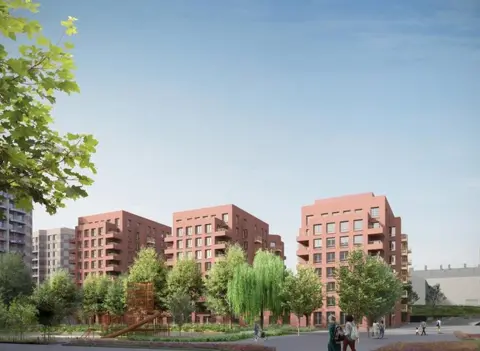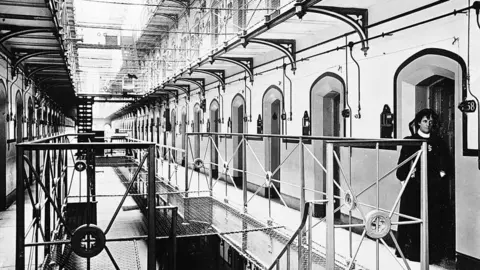Holloway Prison: Design for 1,000 new homes revealed
 Peabody
PeabodyPlans for nearly 1,000 homes at the former Holloway Prison site, which once housed the likes of Myra Hindley and Rose West, have been revealed.
Peabody bought the 10-acre site of the former women's jail in north London in 2019 and its £81.5m project is expected to provide 980 homes.
The housing body said 60% of the homes would be "affordable" housing.
The Ministry of Justice had been looking for a buyer after the prison closed in 2016.
 Heritage Images
Heritage ImagesConstruction work is expected to start next year, with the aim of being completed by 2026.
Peabody and Islington Council are also proposing a "Women's Building" to offer support services and provide a fitting legacy for the site.

 Madam Yevonde
Madam YevondeA brief history of Holloway Prison
- Originally built as a mixed-sex prison in 1852, in 1902 it became the first female-only local prison in England
- In the early 20th Century, suffragettes were imprisoned at Holloway. Many of them went on hunger strike and were subjected to force-feeding
- During World War Two, aristocrat and Hitler-supporter Diana Mosley was imprisoned in Holloway after being deemed "a danger to the King's Realm"
- Ruth Ellis, the last woman to be executed in the UK, was imprisoned in Holloway before her death in 1955
- Other infamous inmates include the mass murderers Myra Hindley and Rose West
- Economist Vicky Pryce was detained in Holloway in 2013 for perverting the course of justice after accepting speeding points on behalf of her then-husband and minister Chris Huhne

Dick Mortimer, Peabody's executive development director, said: "We're excited to be able to present these new proposals to the local community and opening up the space to the public for the first time.
"We want to provide lots of much-needed family sized social homes, but also put dedicated, affordable homes for older people in the heart of the community next to the park."
 Peabody
PeabodyHe added: "The Women's Building will also be a vital part of the neighbourhood and we're looking forward to more discussions around how we can recognise the legacy of the place throughout the design of the wider scheme."
